|
DEPARTMENT OF THE INTERIOR
Conservation in the Department of the Interior |

|
CHAPTER XII
THE COMMITTEE ON THE PUBLIC DOMAIN
THROUGH the year 1930 a committee on the conservation and administration of the public domain prosecuted an extensive study of the problems of the West. That committee had been appointed by President Hoover. Its purpose was to set up where all could see the problems of conservation as they exist to-day. The members were as follows: James R. Garfield, chairman, Cleveland, Ohio; Elwood Mead, representing California; I. M. Brandjord, Helena, Mont.; R. K. Tiffany, Olympia, Wash.; Rudolph Kuchler, Phoenix, Ariz.; Charles J. Moynihan, Montrose, Colo.; George W. Malone, Carson City, Nev.; William Peterson, Logan, Utah; I. H. Nash, Boise, Idaho; Perry Jenkins, Big Piney, Wyo.; E. C. Van Petten, Ontario, Oreg.; Wallace Townsend; Little Rock, Ark.; H. O. Bursum, Socorro, N. Mex.; George Horace Lorimer, Philadelphia, Pa.; James P. Goodrich, Winchester, Ind.; Gardner Cowles, Des Moines, Iowa; Huntley N. Spaulding, Rochester, N. H.; W. B. Greeley, Seattle, Wash.; Mary Roberts Rinehart, Washington, D. C.; and Francis C. Wilson, Santa Fe, N. Mex. In addition the Secretary of the Interior and the Secretary of Agriculture were ex officio members of the committee.
The committee came to the conclusion that the remaining public domain is attracting a rapidly decreasing number of homeseekers, it being generally unsuited for permanent settlement. Even the entries for stock-raising homesteads of 640 acres are slumping. More than half the filings on such homesteads had been allowed to lapse.
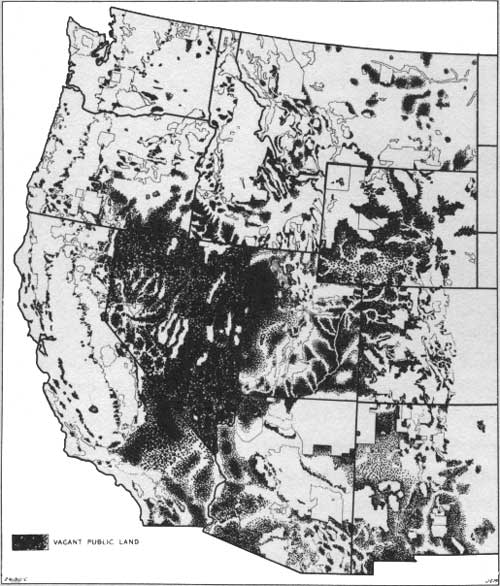
|
| The Government Still Owns the Black Areas |
There are extensive areas in every public-land State which have been entered under this act and then abandoned to Russian thistle and other weeds, some poisonous and destructive to ranges formerly valuable to the stock raiser. Ruined fences and abandoned homes dot the landscape for many miles, pitiful evidence of human hopes buried beneath the economic insufficiency of 640 acres in a semiarid section as a stock-raising unit to support a family. It is not fair to our ex-service men and other homeseekers, the committee thought, to continue in effect an act which has resulted in so many failures and so much misery to settlers. At least it can be stated that little of the land not now entered holds out any hope of economic sufficiency for the permanent establishment of a family on 640 acres unless there is considerable adjoining grazing on the public domain. The uncertainty of the future as to that feature renders a venture on the strength of it perilous indeed. The Federal Government should cease to be a party to the inducement.
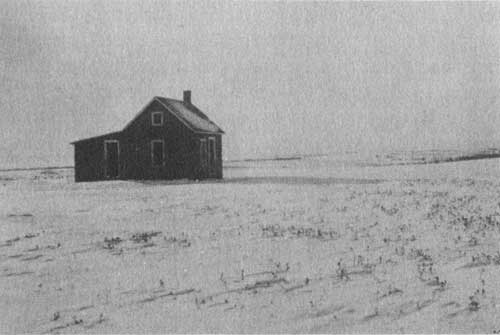
|
| The Federal Government Should Cease to Be a Party to the Establishment of Homes Like This That Are Bound to Fail |
The surface of the public domain, the committee continues, is now and always has been a great grazing common, free to all comers. It is unlawful to fence the land, and no public control has ever been exercised over it. For years recognition has been general that there has not been a wise use of it. To-day overgrazing has taken its toll in the form of large areas unfit for grazing, or a greatly reduced carrying capacity for livestock generally. Erosion has increased by the destruction of forage cover, and the silting of streams and river flow-as an aftermath has added to the problems of range and farm and reclamation. The damage done may never be wholly repaired nor yet its progress wholly arrested; but as a continuing evil it may be diminished, and by proper scientific treatment and regulation many ranges may be steadily improved and carrying capacity increased.
The immediate as well as the ultimate use of the public domain for grazing purposes is a matter of grave national concern, because of the fact that upon that area enormous herds of sheep, cattle, and horses are raised. It should be remembered that about 50 per cent of the sheep and 16 per cent of the cattle of the United States are raised in the public-land States. Hence any serious depletion of the ranges upon which these herds graze is of direct concern to all the people of the United States.

|
| Fifty Per Cent of the Sheep of the Nation Are Raised in the Public-Land States |
Upon the point that some form of regulation of the range is an immediate necessity there is no room for disagreement. The only question is as to the agency which shall be charged with the duty of regulation and the development of the range.
The committee suggested two methods for dealing with this problem: The first was the transfer, with certain reservations, to the States, of the public domain within their respective areas, reserving to the Federal Government such subsoil mineral resources as are now reserved in the Federal Government. The second was the creation on the public domain of a national range to be administered by the United States.
The transfer of the public lands to the States would mean that each State would be charged with the sole obligation of conserving and using the range. The experience of the public-land States in dealing with the large areas now owned by those States and suitable for range shows that in many instances this administration has been effective and salutary. It is true that the public-land States, as their development increases, are becoming increasingly conscious of the value of conservation. The mistakes of the past and the lessons to be learned from that history have not escaped them.
In the event national ranges are created, the committee says, careful consideration should be given to the selection of the Federal agency to be charged with their administration to the end that they may be under a unified control of and under men who are intimately familiar with the conditions of the ranges, wisely established customs of stockmen, the needs of contiguous areas, and the movement of herds and flocks from summer and winter ranges, regardless of political or topographical divisions.
In the event a State accepts the public domain within its areas, says the committee, a number of problems arise. It is apparent that all rights must be protected and the proper forum provided for their definite determination before the transfer of title to a State. The problems involve not only private interests but likewise the interests of the Federal Government. What, for example, should be done about reclamation?
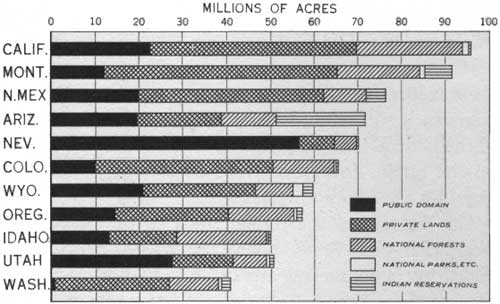
|
| This Chart Shows the Ownership of Land in the Western States |
The public-land States include that vast arid portion of the country where farming is not possible without irrigation. Congress early recognized this essential difference from the rest of the country where settlement under the homestead laws brought about full agricultural development, and enacted the desert land and Carey Acts to supplement the homestead law. Under these laws, by private and community effort, the essential agricultural development of the West received its first impetus. The limit of development by private enterprise was reached when the low-water flow of the streams was all appropriated and it became necessary to provide storage of the floods to be held for use during the dry season. The high cost and long development period of these large projects made them prohibitive from the standpoint of comparatively short-term investments, and many well-intentioned efforts in this direction resulted in total loss of investment not only by the promoters but by thousands of settlers as well. This led to the enactment of the reclamation act designed to make possible in the arid States the building up of farm population and production in fair proportion to the steadily increasing urban population of those States based upon mining, lumbering, and, along the coast, shipping and industrial pursuits.
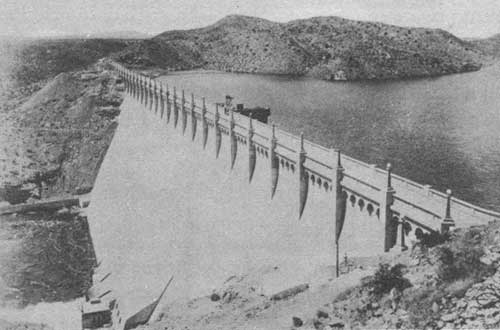
|
| The Government Stopped the Flow of Such Great Streams as the Rio Grande. This Is Elephant Butte Dam in New Mexico |
The reservation of certain vast resources within the Western States for future national needs is one of the major factors making it impossible for these States at the present time to finance their own reclamation requirements.
The reclamation act was originally conceived to supplement private enterprise by the construction or completion of projects beyond the resources of private promotions and individual or collective means. That conception rapidly grew and expanded until the theory of the right of the United States as the proprietor of public lands to improve them by reclamation and irrigation was fully recognized and took form in the construction by the Federal Government of great reclamation projects devoted primarily to that purpose.
Although the development of Federal reclamation is of tremendous importance to the West, the value of crops grown on irrigated lands in these projects is only three-fourths of 1 per cent of the total crop value of the Nation.
Fundamentally it may be said that reclamation has surmounted the barriers of aridity, controlled and converted for useful purposes the menace of the flood, pushed back the frontiers of the desert, and subordinated them all to the service of the purposes of our forefathers in their efforts to establish permanent homes and prosperous communities on the public domain.
The reclamation of the arid and semiarid West is assuming proportions of increasing significance as knowledge and experience enlarge the useful field of our first endeavors and reveal the multiplicity of problems involved in the development and protection of every project. Drainage, colonization, flood control, erosion, power, and kindred subjects have in fact or should become major pieces in the mosaic which is now the Reclamation Service.
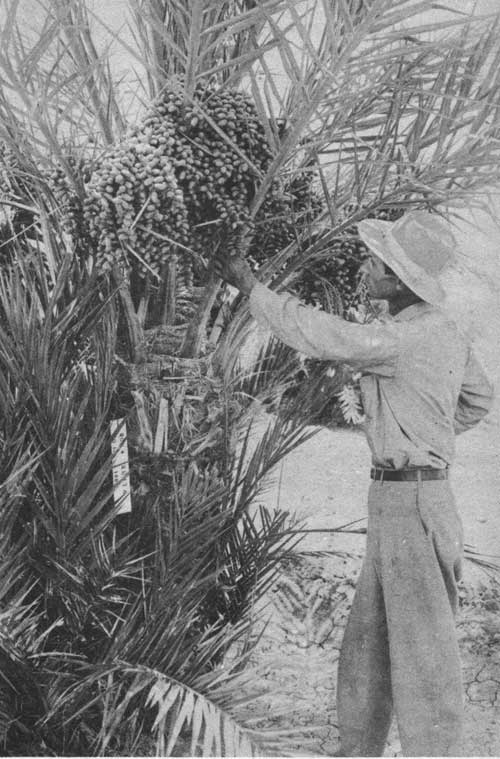
|
| Irrigation Has Brought the Dates of Sahara to the Southwest |
In order that no part which is important to the whole shall be omitted, the committee says, the integrity of the reclamation fund must be guarded carefully. Approximately 67 per cent of the annual income to the fund is from project collections, about 26 per cent from royalties under the mineral leasing act, leaving 7 per cent from all other sources. The primary factor, then, is the safeguarding of project payments, and the secondary is the insurance of the future maintenance of accretions from the royalties received under the mineral leasing act in a percentage at least substantially as at present. The administrative policies of the Reclamation Service, if undisturbed, will assure the first, and nature has apparently undertaken to underwrite the second.
Comparatively recent discoveries of great oil and gas fields in California and New Mexico, where a portion of the public domain participates in their riches, should supply for years to come from permits and leases now in good standing the desired percentage. The public domain in Wyoming has been by far the greatest contributing area in the past and is at present giving promise of continuing that aid. The public domain in Montana, Utah, and Colorado has been and continues to be a hopeful prospect for the future. The immense deposits of coal in the public lands of the Western States, ranging in character from lignite to anthracite, and the deposits of phosphate, sodium, and potash constitute a resource from which future supplies of fuel and fertilizer materials may be derived for national use and will produce an increasingly large revenue. Thus any disposition of the unreserved, unappropriated public domain which does not disturb that desirable condition will withstand attack upon any theory of injury to reclamation.

|
| Under This Salt Surface in a California Desert Is a Lake of Potash |
Moreover, such disposition should be made, with such reservations to the United States, as may certainly provide for future projects when and as economic conditions justify the undertakings.
Much has been accomplished toward flood control by projects already constructed primarily for irrigation, and the Hoover Dam project will reach the apex of achievement for the arid West in that respect. But the far-reaching benefits of each successful project in the protection of lands below the impounding works serve only to intensify recognition of the immensity of the field still unoccupied. None of the public-land States is free from the danger and devastations of floods; but the flood which wipes out a prosperous community or destroys an area in an agricultural district is a national and regional as well as a State calamity, varying in importance only to the extent of the property destroyed and the number of lives wasted. Whether it be the Mississippi at flood with its dreadful potentialities, or the Rio Grande above the Elephant Butte, or the Colorado above Black Canyon after that project has been completed, or any stream in the West subject to the same destructive forces in flood time as are these great river systems, the principle that the problem of control is national and regional, as well as State, remains the same and should be recognized. It varies only in terms of solution, the difficulties, and the costs. It calls for cooperative measures between the Nation and the State, or States, if more than one is benefited, and a just division of costs based upon an appraisal of the benefits received. As an incident to flood-control projects, the generation of power and the development of water for irrigation can be made to pay their part, but the frequent practice of the past of loading all the costs upon the shoulders of the landowner is inequitable. Recognition of that principle appears in the Boulder Canyon project act, under which electric power pays for the dam.
The policy should be enlarged to include all projects now under way or hereafter undertaken until a definite plan of Federal participation has been evolved. Reservoir sites on the public domain have already been located and reserved, and others should be, with a view to future requirements. On interstate streams such sites should be reserved in the United States until the States, by compact ratified by Congress, shall determine their position in the set-up agreed upon by that means.
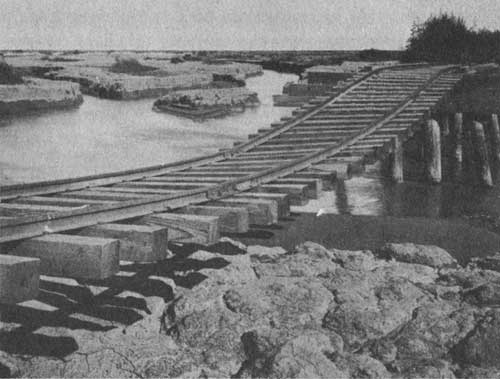
|
| Control of the Flood Waters of Such Streams as the Colorado Is a National Rather Than a State Problem |
Conservation, says the report, has been defined as wise use; but the definition does not satisfy, because what constitutes wise use is the subject of unending controversy. In retrospect we may readily detect the errors of our predecessors and to a limited extent correct them, but our prospective vision is clouded by the human limitations of life and mind. We do know that waste of any natural resource, whether it be one not replaceable because the alchemy of nature can not be duplicated or one renewable by natural processes of growth and rebirth, is a wrong to the generations that will succeed us. The aim of each generation therefore should be to reduce waste to a minimum and to eliminate it where possible. At least, conservation carries a mandate to that extent.
But there is, in the opinion of the committee, a distinction between wanton waste and that which is not voluntary and results from imperfect and inefficient methods of production and utilization in industry and from over production. The first can be remedied by invoking the police powers of Nation and State; the second, only by the education of our people under an enlightened and courageous leadership. In the latter field the usefulness of the Federal agencies is not measurable by, nor dependent upon, nor confined to, the ownership by the United States of a relatively limited quantity of natural resources appertaining to the unreserved, unappropriated public domain. Rather should we think in terms of a practical idealism, relying upon a leadership with ample resources, marshaling the forces of research, of intelligent publicity, of wise instruction on the elimination of waste from production and fabrication and on sound economics, leading the way to a clear understanding of the reasons why waste is the inevitable companion of the uncontrolled production of any natural resource when carried to an unusable excess above the normal requirements of the consuming public.
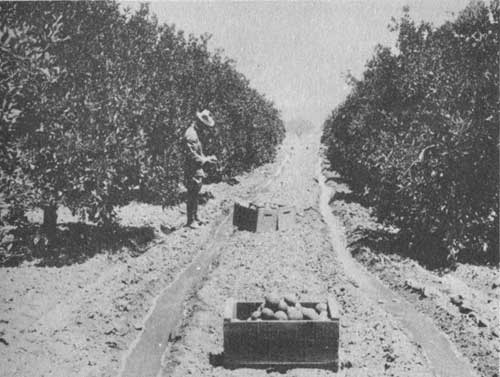
|
| Oranges from the Desert Seem to Meet the Definition of Conservation as Wise Use |
In every public-land State the United States is the owner of vast resources, surface and subsurface, outside of the vacant, unreserved, unappropriated public domain.
The existence of mineral resources in the public lands generally results in the withdrawal or reservation of such lands, and thus their removal from the unreserved, unappropriated public domain. It follows that, theoretically at least, what remains unappropriated and unreserved at this time is for the most part nonmineral in character.
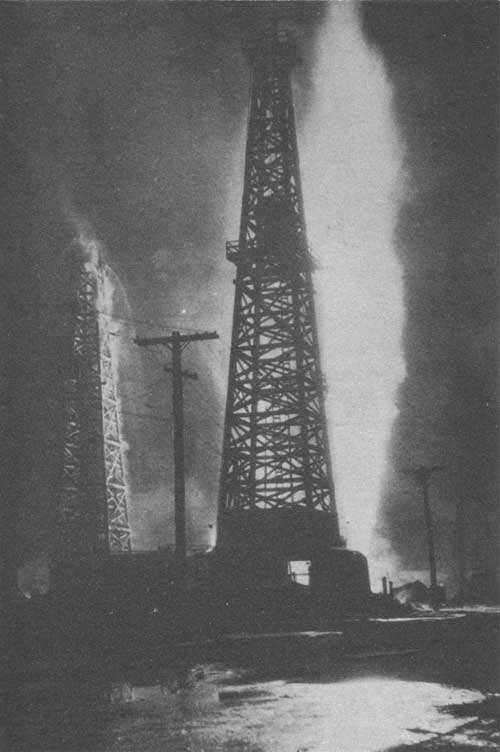
|
| The Solitary Domain May Be Transformed into a Scene Like This |
An important exception probably exists in the presence of oil and gas beneath the surface of a relatively small area of the present public lands. Most of the promising area is now covered by permits to prospect for oil and gas issued by the Interior Department under the mineral leasing act of 1920, and would be excluded in any grant to the States through the clear-listing processes of the General Land Office. In effect the areas covered by permits are withdrawn from the public domain so long as they are in good standing. On June 30, 1930, there were 676 oil and gas leases and 6,482 permits to prospect for oil and gas outstanding, covering an estimated area of 15,000,000 acres.
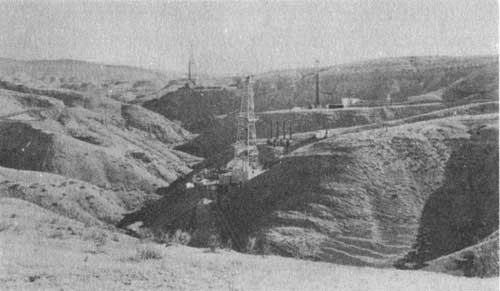
|
| Oil on Government Land in Kettleman Hills, California |
From the standpoint of participation in conservation programs of the near future by the United States the last figure has vastly more significance than present withdrawals for oil and gas and for oil shales. Present waste in the oil and gas industry can be laid largely at the door of overproduction. To bring about some measure of cooperation to reduce that dangerous factor the prorating of pipe-line runs and the unit operation of a producing field have been suggested and are being tried out. Both methods promise relief if legal difficulties and individual instances of selfishness do not bar the way.
So far as leases issued by the Secretary of the Interior are concerned, following discovery by the permit holder or his assigns, the power to require the lessee to enter into prorating or unit-operation agreements is lost the moment the lease takes effect, and to that extent the control of the Federal Government over this important feature of any conservation program is gone. The committee suggests that if the mineral leasing act does not give sufficient authority to the Secretary of the Interior to include provisions in the lease reserving the right to him to require of the lessee or his assigns compliance with agreements for prorating of pipe-line runs, or for unit operation, as the case may be, of a field where two-thirds in interest of the operators in the field have so agreed, then the act should be amended to give him that authority.
The reason for the conclusion is that the permit gives only the right to prospect until oil and gas are discovered, whereas the lease gives the right to produce, and it is at the latter juncture that the danger point impends and should be averted if possible.

|
| If the Grass Cover Is Maintained, Erosion Will Be Avoided |
Under present conditions, especially as to the permit situation as above stated, it is unlikely that the States accepting the grant would acquire much land valuable for oil and gas. The discussion, therefore, is not particularly pertinent to such grants except in so far as the example of the Federal Government would be valuable as a precedent for those States which now have the same or similar problems before them in connection with presently owned State lands.
In dealing with the conservation of the public domain it is recognized that erosion is playing an important part. In large areas erosion of the soil is shown to be more rapid than where settlement began. This is even serious in certain areas.
The balance, established by nature, between soil type, gradient, vegetative cover, and rainfall has been disturbed. There has probably been little change in rainfall during the past 100 years; the gradient and soil type have remained the same. The greatest disturbance has been in the vegetative covers. Plant growth depends on plant food and moisture. The limiting factor in plant food is usually nitrogen. The nitrogen has its supply in the organic matter of the soil. The nitrifying bacteria live in this organic material and make available nitrogen. If the vegetative cover is grazed too closely, the annual organic contribution to the soil gradually grows less. The plants become stunted, even starved, and the better forage plants, such as grasses, give way to poorer plants, even poisonous plants. The multiple-root system of grasses is lessened. The partial sod cover is replaced by isolated plants. Less moisture is retained after each rainstorm. Nitrogen which is available for plant food is soluble. More run-off means chemical erosion of plant food.
When the soil is denuded to this condition it will readily disintegrate. The surface is broken and gullying begins. Erosion is a problem associated with the hazards of floods and silting of streams and reservoirs. Whenever the amount of organic matter in the surface soil of any part of the public domain fails to maintain, erosion becomes a problem of conservation. Experiments indicate that from 10 to 15 per cent of the total plant growth of the year should return as an organic contribution of the soil in order to maintain the forage cover. When the plants have been greatly denuded, it may take from 30 to 40 years under wise use to rehabilitate the area.
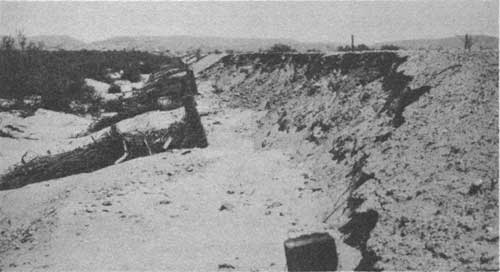
|
| As Rain Water Cuts the Plain That Is Without a Cover of Vegetation |
The perpetuation of the plant food tied up in the organic matter of the upper soil determines the value in forage growth; measured in grazing, it is as vital a factor in conservation as is the wise use of oils, gas, or mineral and, if it could be measured with the same accuracy, would show a value running into millions. The preservation of plant food, soil cover, and normal erosion is a problem in conservation on the public domain for future administration.
The committee arrived at five general conclusions.
It thought that all portions of the unreserved and unappropriated public domain should be placed under responsible administration or regulation for the conservation and beneficial use of its resources.
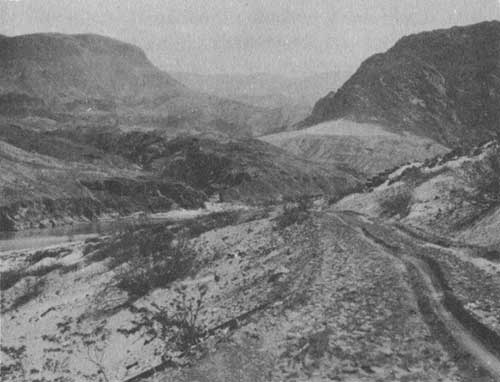
|
| A Western Landscape |
It believed that additional areas important for national defense, reclamation purposes, reservoir sites, national forests, national parks, national monuments, and migratory-bird refuges should be reserved by the Federal Government for these purposes.
It was convinced that the remaining areas, which are valuable chiefly for the production of forage and can be effectively conserved and administered by the States containing them, should be granted to the States which will accept them.
It recommended that in States not accepting such a grant of the public domain responsible administration or regulation should be provided.
It believed that when a conservation program based on uniformity of Federal and State legislation and administration is developed and accepted by a State, its mineral resources should be transferred to the State under such restrictions as will properly safeguard the accepted principles of conservation and the reclamation fund.
The committee made 20 recommendations.
It wanted Congress, under prescribed conditions, to turn over public lands to the States.
It wanted public lands in States not accepting them administered as "national ranges."
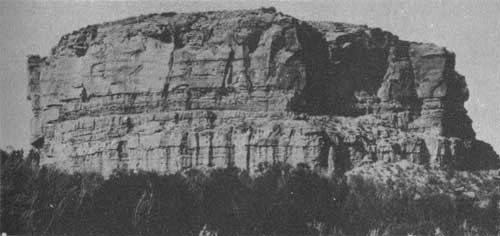
|
| Pompey's Pillar |
It wanted nonmineral lands transferred to the States in fee simple, but known minerals, together with the right to take them out, reserved to the Federal Government.
It wanted certain forest, national park, and reclamation areas excepted until their status was determined.
It wanted authorization extended to the proper officials to swap lands with States and private owners in the interest of consolidation of holdings.
"To provide for a more effective administration of the public domain and the various reservations and areas now under the control of the Federal Government and to promote the conservation of natural resources," it wrote, "it is recommended that the Congress be asked to authorize the President to consolidate and coordinate the executive and administrative bureaus, agencies, and offices created for or concerned with the administration of the laws relating to the use and disposition of the public domain, the administration of the national reservations, and the conservation of natural resources."
| <<< Previous | <<< Contents>>> | Next >>> |
interior-conservation/chap12.htm
Last Updated: 20-Jul-2009